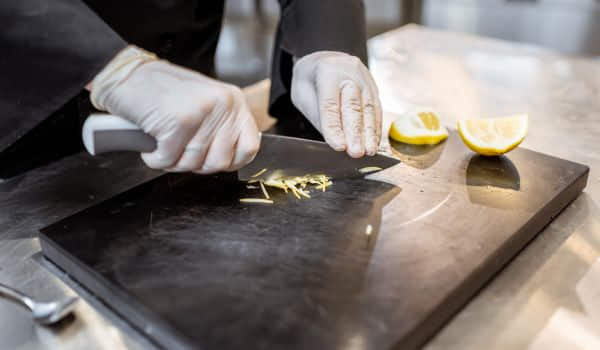Lemon zest, prized for its vibrant flavor and aromatic essence, adds a delightful tanginess to various culinary creations. While a traditional grater is often the go-to tool for obtaining this zest, there are several ingenious alternatives available for extracting that essential lemon essence without a grater.
These methods, utilizing everyday kitchen tools or techniques, offer practical solutions for acquiring zing, ensuring your dishes burst with the zesty goodness of citrus.
Using a Vegetable Peeler

Selecting a sharp vegetable peeler
Selecting a sharp vegetable peeler is crucial for effectively obtaining lemon zest without a grater. Ensure the peeler has a sharp blade to effortlessly remove the zing from the lemon’s surface.
Opt for a peeler with a comfortable grip, allowing better control and precision while peeling.
Washing and drying the lemon
Before beginning the zesting process, thoroughly wash and dry the lemon. Washing helps eliminate any dirt or residue on the surface, while drying ensures a better grip and ease of peeling.
A dry lemon makes it easier to maneuver the peeler across the surface without slipping.
Peeling thin strips of zest
Using the selected vegetable peeler, carefully peel thin strips of zing from the lemon’s outer layer. Apply gentle pressure and move the peeler in a consistent motion along the Citrus’s surface to collect the zest.
Aim for thin strips to acquire the zing without including the bitter white pith underneath.
Cutting strips into fine pieces
Once the thin strips of zest are obtained, proceed to cut them into fine pieces using a sharp knife. This step further refines the zest, ensuring it’s finely chopped and ready to impart its citrusy essence to your culinary creations.
Chop the strips into small, uniform pieces, suitable for sprinkling or incorporating into recipes as needed.
Knife Method

Selecting a sharp knife
Begin by selecting a sharp knife suitable for zest removal. A smaller, sharp paring knife or a utility knife with a fine edge works well for this task.
The sharpness of the knife is crucial to efficiently and precisely remove the zing without including the bitter pith beneath.
Washing and drying the lemon
Prior to zesting, thoroughly wash and dry the lemon. Washing removes any impurities or residue on the skin, while drying ensures a better grip and control while using the knife. A dry lemon facilitates smoother and safer cutting.
Removing the zest in thin strips
Carefully remove the zest from the lemon by cutting thin strips with the selected sharp knife. Glide the knife along the citrus’s surface, aiming for thin strips of zing without incorporating the bitter white pith.
Exercise caution to maintain a consistent thickness while cutting to maximize the zest yield.
Chopping the zest finely with the knife
After obtaining the thin strips of zest, finely chop them with the knife on a cutting board. Ensure the chopping motion is steady and precise to achieve finely minced zing.
This process breaks down the strips into smaller, manageable pieces, perfect for enhancing the flavor profile of your dishes or beverages. Aim for a uniform size to evenly distribute the zest’s citrusy essence.
Using a Citrus Zester

Explaining a citrus zester
A citrus zester is a specialized kitchen tool designed for effortlessly extracting zest from citrus fruits. It typically consists of a handle and a narrow, sharp-edged surface featuring small holes or sharp edges.
This tool efficiently removes the flavorful outer layer of the citrus fruit while leaving behind the bitter pith, resulting in finely grated zing perfect for culinary applications.
Washing and drying the lemon
To prepare the lemon with a citrus zester, start by thoroughly washing it under running water to eliminate any dirt or residue. Once cleaned, ensure the citrus is completely dry before zesting.
The dry surface facilitates better adherence of the zing to the zester’s blade.
Dragging the zester across the lemon
With the dried lemon in hand, firmly glide the citrus zester across the lemon’s surface. Apply gentle pressure while moving the zester in a consistent motion to grate the zing.
The sharp edges or perforations of the zester will efficiently remove the zing without penetrating the bitter white pith, resulting in fine, flavorful strands of zing.
Crushing Method

Washing and drying the lemon
Start by thoroughly washing the lemon under running water to remove any impurities or residues present on the surface. Once washed, ensure the citrus is completely dry before proceeding with the crushing method.
A dry citrus surface aids in better extraction of oils from the zing.
Rolling the lemon to release oils
To release the essential oils and the lemon, gently roll the dried citrus on a countertop using the palm of your hand. Applying slight pressure while rolling helps to break down the zing and release the flavorful oils trapped within the pores.
This process softens the zest and prepares it for further extraction.
Using a mortar and pestle or rolling pin
Utilize a mortar and pestle or a rolling pin for the crushing process. Place the rolled lemon on a sturdy surface and either use the mortar and pestle to grind and crush the zest or employ a rolling pin to firmly roll and press down on the citrus.
Apply moderate pressure to break the zest and release the aromatic oils contained within it.
Collecting the released zest
Collect the released zest from the surface where the crushing occurred. Scrape off the crushed using a spoon, spatula, or any suitable kitchen utensil. Ensure all the extracted zest is gathered and transferred to a bowl or container for immediate use or storage.
The collected zing from the crushing method can infuse its citrusy essence into dishes or beverages, enhancing their flavor profiles.
Read More: How To Shred Cheese Without A Grater
Conclusion
In exploring various alternative methods to zing a lemon without a grater, it’s evident that simple kitchen tools and techniques can efficiently extract the vibrant essence of lemon zest. From using vegetable peelers, knives, citrus zesters, to crushing the zing, these methods showcase the versatility of everyday kitchen items in obtaining that citrusy goodness.
Encouraging experimentation with different approaches, these methods underscore the adaptability of common tools, offering options suited to individual preferences. Incorporating citrus only adds a burst of tangy flavor but also infuses recipes with a refreshing aroma, enhancing the overall taste profile of dishes and beverages, making it an invaluable ingredient in culinary creations.




